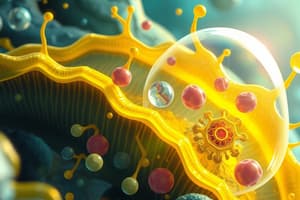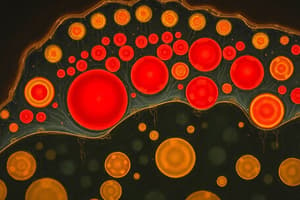Podcast
Questions and Answers
A researcher is studying a cell under a microscope and observes a distinct nucleus and several membrane-bound organelles. Which of the following classifications BEST describes this cell?
A researcher is studying a cell under a microscope and observes a distinct nucleus and several membrane-bound organelles. Which of the following classifications BEST describes this cell?
- Eukaryotic (correct)
- Archaeal
- Prokaryotic
- Bacterial
If a cell were unable to perform exocytosis, what would be the MOST likely consequence for the cell?
If a cell were unable to perform exocytosis, what would be the MOST likely consequence for the cell?
- The cell would be unable to transport proteins into the nucleus.
- The cell would be unable to release proteins or waste products to the exterior. (correct)
- The cell would be unable to perform photosynthesis.
- The cell would be unable to synthesize ATP.
A certain liver cell is heavily involved in detoxification. Which of the following organelles would you expect to be found in abundance in this cell?
A certain liver cell is heavily involved in detoxification. Which of the following organelles would you expect to be found in abundance in this cell?
- Lysosomes
- Rough Endoplasmic Reticulum
- Golgi Apparatus
- Smooth Endoplasmic Reticulum (correct)
A scientist observes that a cell membrane is highly permeable to water but only slightly permeable to sodium ions. Which of the following BEST explains this observation?
A scientist observes that a cell membrane is highly permeable to water but only slightly permeable to sodium ions. Which of the following BEST explains this observation?
Cells in a freshwater environment tend to gain water due to osmosis. Which modification to the cell membrane would BEST protect the cell from lysis?
Cells in a freshwater environment tend to gain water due to osmosis. Which modification to the cell membrane would BEST protect the cell from lysis?
A cell must import a large molecule against its concentration gradient. Which transport mechanism is MOST appropriate and efficient for this task?
A cell must import a large molecule against its concentration gradient. Which transport mechanism is MOST appropriate and efficient for this task?
During protein synthesis, a mutation occurs that prevents the ribosome from correctly reading the mRNA sequence. At which step would protein synthesis be halted?
During protein synthesis, a mutation occurs that prevents the ribosome from correctly reading the mRNA sequence. At which step would protein synthesis be halted?
You are studying a newly discovered organism and find that it synthesizes proteins using a slightly different genetic code than other known organisms. While the central dogma (DNA -> RNA -> Protein) still applies, which cellular component likely differs MOST significantly in this organism compared to others?
You are studying a newly discovered organism and find that it synthesizes proteins using a slightly different genetic code than other known organisms. While the central dogma (DNA -> RNA -> Protein) still applies, which cellular component likely differs MOST significantly in this organism compared to others?
Flashcards
Prokaryotic Cells
Prokaryotic Cells
Cells lacking a nucleus and membrane-bound organelles.
Eukaryotic Cells
Eukaryotic Cells
Cells with a nucleus and membrane-bound organelles.
Nucleus
Nucleus
The organelle that stores genetic material (DNA) and is the site of transcription.
Endoplasmic Reticulum (ER)
Endoplasmic Reticulum (ER)
Signup and view all the flashcards
Golgi Apparatus
Golgi Apparatus
Signup and view all the flashcards
Cholesterol (in cell membranes)
Cholesterol (in cell membranes)
Signup and view all the flashcards
Diffusion
Diffusion
Signup and view all the flashcards
Central Dogma of Molecular Biology
Central Dogma of Molecular Biology
Signup and view all the flashcards
Study Notes
- Key concepts related to cellular ultrastructure, cell membranes, membrane transport, and the central dogma of molecular biology
Prokaryotic vs. Eukaryotic Cells
- Prokaryotic cells lack a nucleus, are simple in structure, and include bacteria and archaea
- Eukaryotic cells possess a nucleus, membrane-bound organelles, and are more complex
Cell Organelles & Functions
- Nucleus stores genetic material(DNA) and is the site of transcription
- Rough ER facilitates protein synthesis
- Smooth ER is involved in lipid synthesis and detoxification
- Golgi apparatus modifies and packages proteins
- Mitochondria generate ATP and serve as the powerhouse of the cell
- Cholorplasts conduct photosynthesis in plants
- Lysosomes contain digestive enzymes and facilitate the breakdown of waste
- Cytoskeleton provides structural support and enables movement
- Centrioles function in cell division and microtubule organization
Cell Membranes
- Phospholipids are amphipathic molecules with hydrophilic heads and hydrophobic tails
- Integral membrane proteins are involved in transport and cell signaling
- Peripheral membrane proteins attach to the surface and participate in enzyme activity
- Cholesterol maintains membrane fluidity
- Selective permeability restricts which substances can cross the membrane
Membrane Transport
- Passive transport does not require ATP
- Diffusion is movement from high to low concentration
- Osmosis is water diffusion across a membrane
- Facilitated diffusion involves transport proteins that aid movement
- Active transport requires ATP
- Primary active transform directly uses ATP, like the Na+/K+ pump
- Secondary active transport uses ion gradients, like the sodium-glucose transporter
- Hypotonic solutions cause water to enter cells, potentially leading to lysis
- Hypertonic solutions cause water to exit cells, leading to crenation
- Isotonic solutions result in no net water movement
- Endocytosis involves the cell engulfing substances through phagocytosis or pinocytosis
- Exocytosis involves vesicles releasing contents outside of the cell
Central Dogma of Molecular Biology
- DNA leads to RNA leads to Protein
- During transcription, DNA converts to mRNA in the nucleus
- During translation, mRNA converts to protein in the ribosomes
- Ribosomes are the sits of protein syntheis
Studying That Suits You
Use AI to generate personalized quizzes and flashcards to suit your learning preferences.




